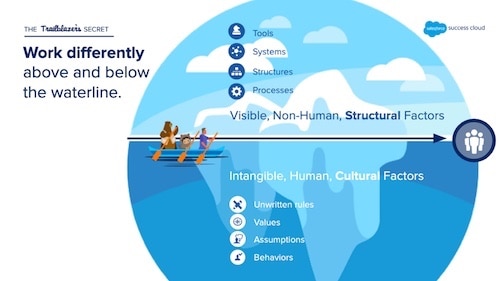Over the last 300 years, we’ve gone through different industrial revolutions — steam, electricity, computing, and now intelligence. This Fourth Industrial Revolution introduces new technologies such as IoT, artificial intelligence, and data science.
These technologies aid sales but also aid customers — because customers are now far more intelligent. Organizations are trying to transform with these new technologies, but unfortunately, they’re not always successful. In fact, 90% of organizations fail to become digital, with some of the common causes:
- Lack of alignment between business and IT
- No clear plan
- Talent or skill gaps
- Cultural resistance
Sales reps are the ones who suffer. Failed digital transformation means less time for selling because it takes the rep away from the customer and increases the rep’s number of administrative tasks. The data backs it up. Two-thirds of a sales rep’s time is spent on activities other than selling.

But regardless of how difficult it may be at times, digitization isn’t going away. Customers keep getting smarter and expecting more from organizations. Just look at how customers now choose tax accountants based on their ability to submit and sign documents electronically rather than physically.
What are the 10% of companies that have succeeded in their digital transformation doing? They embrace the need to work differently. I like to use the iceberg analogy, which shows the necessity of working differently both above and below the waterline. Above the waterline are visible, non-human, structural factors, such as systems, tools, structures, and processes. Below the waterline are intangible, human, cultural factors, such as unwritten rules, values, assumptions, and behaviors. You need to address both for a successful digital transformation.
Above the waterline
So what are some of the new structures necessary to get ahead in the digital age? There are four that we see trend across organizations:
- Intelligence for sales: AI-powered salespeople will have an edge. 80% of Sales teams using artificial intelligence report a positive impact on customer retention, and 72% of business leaders say that AI is a business advantage. AI gives time back to sales reps and allows them to focus on what really matters — building relationships.
- Sales leaders taking over technology: The sales org needs to move fast. If IT doesn’t respond with speed and agility to technology requests from sales, CRM executives will bypass IT and pick their own solutions. In progressive organizations, we see sales teams equipped with technology leaders, admins, developers, and architects who build up their sales apps and deliver new technology.
- Mobility: A Gartner study reports that manual data entry by salespeople for Salesforce automation systems will be reduced by 50% due to the adoption of mobile sales productivity tools. Most salespeople live and die by their phones, so why not enable them to do their job via handheld devices? With this capability, reps will always have a real-time view of their sales’ pipe and can easily pivot based on information they can access on their phones.
- Coaching: Training alone isn’t enough. Information retention drops within the first 20 minutes after training and continues to drop until only 20% is retained after one month. But when you combine training with coaching empowered by the sales manager, retention jumps to 88%. With that increased retention comes the confidence that reps execute on a process proven to drive success in your organization.
Below the waterline
Now let’s look at some of the cultural aspects of working in new ways. We’ve found four cultural characteristics driving success at progressive sales orgs:
- Customer-obsessed: Create an environment where customer obsession is led by leadership and where there is a focus on customer experience throughout the sale. Reps need to focus their efforts around creating value for the customer. Our Co -CEO Marc Benioff always says, “As a company, you need to get to the future first, ahead of your customers, and be ready to greet them when they arrive.” It’s no longer about the rep’s time and process; rather, it’s about giving the customer what they want and need and making it a positive experience for them. The most successful companies move customers to the center of their business and make decisions based on those customers.
- Nimble and collaborative: Sales is a team sport, not an individual one. Find people who are collaborative and focus on winning for everybody. You’ll often have different salespeople contacting the same customer several times, so it’s critical that you develop a cross-functional sales team focused on that customer.
- Open and accountable: Create a trusting environment where sales reps are comfortable with candidly sharing their concerns and ideas and sales leaders take that feedback seriously. Google did a study on high-performing teams, measuring them to see which factors made them the most successful. It wasn’t qualifications or intelligence — it was psychological safety that gives team members the ability to be open, honest, and transparent.
- Risk-taking and innovative: By nature, many sales reps are risk-takers. Encourage risk-taking and help reps see failure as a learning opportunity. When a rep loses an opportunity, don’t point a finger and get upset. Instead, treat it as an opportunity to examine what went wrong and then move forward.
These below-the-waterline activities are crucial. In the face of the significant changes in the sales industry, those activities will be the ones that really move the needle. Helping is the new selling, and customers want to work with people who are productive, collaborative, nimble, connected, well-informed, and open.
So what’s the takeaway? Your digital sales success depends on your sales force working in new ways, with new technologies, cultures, and structures. It’s not enough to just plop a new system or structure in place. That needs to be combined with new cultural characteristics and new ways of working. If you put in the effort, you’ll also reap the rewards. Digital sales success results in increased revenue, lead-conversion win rates, sales productivity, and forecast accuracy. With all that on the line, why not give it a try?
Learn more about how other organizations blaze their trail to digital transformation.




























